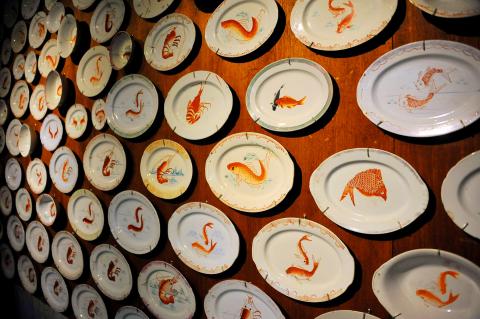Chien Yang-tung (簡楊同) had been collecting Chinese pottery for about five years when he came across his first Taiwanese piece about 20 years ago. It was a small dish adorned with hand-painted pink flowers produced in the pottery capital of Yingge (鶯歌) in the 1960s.
“It sent a shockwave through my body,” he says. “It was obviously distinct from what I had been collecting, yet it was so beautiful.”
His collection has grown so much that he is selling duplicates out of his stash of over 30,000 pieces in front of his Taiwan Bowl and Dish Museum (台灣碗盤博物館), which reopened to the public in a new beton brut-style building on April 21 in Chien’s hometown of Wujie Township (五結鄉), Yilan County. Originally located in nearby Yuanshan Township (員山), Chien closed the museum in December 2016 after its lease expired. Not all of the pieces survived the move across the Lanyang River (蘭陽溪), but Chien doesn’t seem to mind because no favorites were lost.

Photo: Han Cheung, Taipei Times
For the past year, Chien says he has been focused on the construction of the four-story concrete structure, in which just the permanent displays on the first two floors are available for viewing. It’s impressive enough with about 5,000 pieces on display, and Chien is looking to use the remaining two floors for special exhibitions.
While the old museum featured a number of pieces from China and Japan, the new permanent display mainly focuses on Taiwan-related wares, including a number of rare polychrome, hand-painted underglaze dishes that were only made from the end of World War II until mass production took over in the 1970s.
“I started out collecting Chinese ceramics and porcelain, and only later did I notice that Taiwanese ones had a distinct character to them,” Chien says. “Every culture in the world makes pottery, and it’s not easy to stand out from the pack.”

Photo courtesy of Taiwan Bowl and Dish Museum
MADE IN TAIWAN
Chien stares at a backless shelf full of bowls in front of a large glass window, with the lush rice paddies across the street providing a soothing background. However, he’s not pleased.
“Someone came and said the window is backlighting the wares, so I have to make adjustments,” he says.
Chien is holding off his grand opening indefinitely as he gathers feedback from visitors to optimize his permanent exhibition. There’s still much work to do, including adding individual labels to each piece as well as translating the detailed descriptions into English. Research is also in progress — there’s a section that highlights the manufacturers’ logos on the bottom of the wares, but Chien is still trying to figure out the identity of several who show only English initials such as “LCF” and “DF.”
Chien has been an avid treasure hunter — rare stamps, records, religious figurines — since he was young. He says he could always find something at flea markets while his friends came up empty-handed. But his love affair with pottery didn’t begin until China opened up in the late 1980s and Chinese porcelain wares became more accessible in Taiwan.
What was more of a hobby became a passion after that fateful encounter with his first Taiwanese dish two decades ago. Since the type of local ware he sought is relatively modern and were used as everyday objects, they weren’t hard to find — collectors, museums and academics paid little attention to them, preferring to focus on delicate and rare Chinese or Japanese antiques. Chien, who was born in 1964, grew up in the era of mass production but recalls seeing similar objects at banquets or temple festivals when he was younger.
“These bowls and dishes reflected Taiwanese society [after the war],” he says. “They were used by every household, rich or poor. I felt in them a sense of familiarity. They spoke to me,” he says.
Before he knew it, his collection ballooned. “That’s how collecting works,” he says. “It seems that objects know how to find their owners.”
Aborigines have been making pottery in Taiwan for 6,000 years, but they were fired in open pits instead of kilns. Han Chinese immigrants brought their expertise to the island, which developed unique characteristics over the centuries. Due to the lack of local kaolinite, the main ingredient in porcelain, Taiwanese produced stoneware, which is more opaque with grayer or browner tones depending on the clay used, Chien says.
Taiwanese wares bear much similarity to those produced in China’s Fujian province, where most Han Chinese immigrants hailed from. Chien says they are recognizable not only through the material but also by the pastel palette with lots of pink and muted colors, while Chinese products tend to favor bolder tones like vermilion red. Tropical motifs such as palm trees were popular in both southern China and Taiwan, but Chien says Chinese depictions of the trees are generally more slender and delicate. Taiwanese designs are warm and passionate, Chien says, not as bold as Chinese designs but fancier than Japan’s minimalist ethos.
“Taiwan’s problem is that the National Palace Museum [which mostly displays Chinese artefacts] had long-dominated the scene,” Chien says. “These local products were mostly ignored.”
LIMITED RELEASE
Of the Taiwanese products, Chien finds those produced from post World War II to the 1970s the most fascinating. Production increased because Taiwan didn’t trade with China, and around the same time polychrome underglaze techniques had matured enough for larger-scale production.
Many of these wares feature similar decorations as manufacturers would copy each other’s best-selling designs. For example, the museum shows an entire wall of dishes with red shrimp, fish and lobster illustrations — reflecting times where people were too poor to eat seafood regularly. These hand-drawn plates soon went out of fashion as mass production took off in the 1970s.
“This style did not exist before that period, and there won’t be any more made,” he says.
Of the non-Taiwanese pieces, Chien focuses on Zhangzhou wares (漳州窯), a city on the Fujian coast that became a key port of the maritime silk road during the Ming Dynasty. Since they were mainly exported, they were tailored for foreign buyers with Japanese and Arabic phrases and other unusual decorations. The Fujianese pirate Cheng Chih-lung (鄭芝龍) and his son Cheng Cheng-kung (鄭成功, also known as Koxinga) were prominent traders in the area, and the younger Cheng eventually established a kingdom around today’s Tainan area.
Don’t expect the museum to be complete anytime soon — Chien remains mum on when he will host his grand opening.
“Maybe when I finish my next building,” he says, pointing to an empty field next to the museum, adding that he may have found a new addiction in construction. “That may take another year.”

The Nuremberg trials have inspired filmmakers before, from Stanley Kramer’s 1961 drama to the 2000 television miniseries with Alec Baldwin and Brian Cox. But for the latest take, Nuremberg, writer-director James Vanderbilt focuses on a lesser-known figure: The US Army psychiatrist Douglas Kelley, who after the war was assigned to supervise and evaluate captured Nazi leaders to ensure they were fit for trial (and also keep them alive). But his is a name that had been largely forgotten: He wasn’t even a character in the miniseries. Kelley, portrayed in the film by Rami Malek, was an ambitious sort who saw in

It’s always a pleasure to see something one has long advocated slowly become reality. The late August visit of a delegation to the Philippines led by Deputy Minister of Agriculture Huang Chao-ching (黃昭欽), Chair of Chinese International Economic Cooperation Association Joseph Lyu (呂桔誠) and US-Taiwan Business Council vice president, Lotta Danielsson, was yet another example of how the two nations are drawing closer together. The security threat from the People’s Republic of China (PRC), along with their complementary economies, is finally fostering growth in ties. Interestingly, officials from both sides often refer to a shared Austronesian heritage when arguing for

Among the Nazis who were prosecuted during the Nuremberg trials in 1945 and 1946 was Hitler’s second-in-command, Hermann Goring. Less widely known, though, is the involvement of the US psychiatrist Douglas Kelley, who spent more than 80 hours interviewing and assessing Goring and 21 other Nazi officials prior to the trials. As described in Jack El-Hai’s 2013 book The Nazi and the Psychiatrist, Kelley was charmed by Goring but also haunted by his own conclusion that the Nazis’ atrocities were not specific to that time and place or to those people: they could in fact happen anywhere. He was ultimately

Last week gave us the droll little comedy of People’s Republic of China’s (PRC) consul general in Osaka posting a threat on X in response to Japanese Prime Minister Sanae Takaichi saying to the Diet that a Chinese attack on Taiwan may be an “existential threat” to Japan. That would allow Japanese Self Defence Forces to respond militarily. The PRC representative then said that if a “filthy neck sticks itself in uninvited, we will cut it off without a moment’s hesitation. Are you prepared for that?” This was widely, and probably deliberately, construed as a threat to behead Takaichi, though it